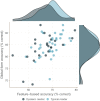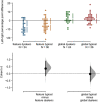Faces and words are both associated and dissociated as evidenced by visual problems in dyslexia
- PMID: 34837013
- PMCID: PMC8626489
- DOI: 10.1038/s41598-021-02440-7
Faces and words are both associated and dissociated as evidenced by visual problems in dyslexia
Abstract
Faces and words are traditionally assumed to be independently processed. Dyslexia is also traditionally thought to be a non-visual deficit. Counter to both ideas, face perception deficits in dyslexia have been reported. Others report no such deficits. We sought to resolve this discrepancy. 60 adults participated in the study (24 dyslexic, 36 typical readers). Feature-based processing and configural or global form processing of faces was measured with a face matching task. Opposite laterality effects in these tasks, dependent on left-right orientation of faces, supported that they tapped into separable visual mechanisms. Dyslexic readers tended to be poorer than typical readers at feature-based face matching while no differences were found for global form face matching. We conclude that word and face perception are associated when the latter requires the processing of visual features of a face, while processing the global form of faces apparently shares minimal-if any-resources with visual word processing. The current results indicate that visual word and face processing are both associated and dissociated-but this depends on what visual mechanisms are task-relevant. We suggest that reading deficits could stem from multiple factors, and that one such factor is a problem with feature-based processing of visual objects.
© 2021. The Author(s).
Conflict of interest statement
The authors declare no competing interests.
Figures




Similar articles
-
Specific problems in visual cognition of dyslexic readers: Face discrimination deficits predict dyslexia over and above discrimination of scrambled faces and novel objects.Cognition. 2018 Jun;175:157-168. doi: 10.1016/j.cognition.2018.02.017. Epub 2018 Mar 16. Cognition. 2018. PMID: 29544151
-
Featural and configural processing of faces and houses in matched dyslexic and typical readers.Neuropsychologia. 2021 Nov 12;162:108059. doi: 10.1016/j.neuropsychologia.2021.108059. Epub 2021 Oct 9. Neuropsychologia. 2021. PMID: 34637801
-
Own-race and other-race face recognition problems without visual expertise problems in dyslexic readers.Vision Res. 2019 May;158:146-156. doi: 10.1016/j.visres.2019.02.010. Epub 2019 Mar 12. Vision Res. 2019. PMID: 30831116
-
Whole-object effects in visual word processing: Parallels with and differences from face recognition.Cogn Neuropsychol. 2021 May;38(3):231-257. doi: 10.1080/02643294.2021.1974369. Epub 2021 Sep 16. Cogn Neuropsychol. 2021. PMID: 34529548 Review.
-
Mirrors are hard to break: A critical review and behavioral evidence on mirror-image processing in developmental dyslexia.J Exp Child Psychol. 2017 Jul;159:66-82. doi: 10.1016/j.jecp.2017.02.003. Epub 2017 Mar 9. J Exp Child Psychol. 2017. PMID: 28285044 Review.
Cited by
-
The Role of Visual Factors in Dyslexia.J Cogn. 2023 Jun 29;6(1):31. doi: 10.5334/joc.287. eCollection 2023. J Cogn. 2023. PMID: 37397349 Free PMC article.
-
Faces, English words and Chinese characters: a study of dual-task interference in mono-and bilingual speakers.Exp Brain Res. 2023 Apr;241(4):1131-1144. doi: 10.1007/s00221-023-06580-2. Epub 2023 Mar 1. Exp Brain Res. 2023. PMID: 36856801 Free PMC article.
-
Prosopagnosia is highly comorbid in individuals with probable developmental coordination disorder.Q J Exp Psychol (Hove). 2025 Aug;78(8):1501-1522. doi: 10.1177/17470218241275977. Epub 2024 Aug 13. Q J Exp Psychol (Hove). 2025. PMID: 39138399 Free PMC article.
-
Domain Specificity vs. Domain Generality: The Case of Faces and Words.Vision (Basel). 2023 Dec 21;8(1):1. doi: 10.3390/vision8010001. Vision (Basel). 2023. PMID: 38535755 Free PMC article. Review.
-
Atypical reliance on monocular visual pathway for face and word recognition in developmental dyslexia.Brain Cogn. 2024 Feb;174:106106. doi: 10.1016/j.bandc.2023.106106. Epub 2023 Nov 28. Brain Cogn. 2024. PMID: 38016399 Free PMC article.
References
-
- Cox DD. Do we understand high-level vision? Curr. Opin. Neurobiol. 2014;25:187–193. - PubMed
-
- Logothetis NK, Sheinberg DL. Visual object recognition. Annu. Rev. Neurosci. 1996;19:577–621. - PubMed
-
- Milner D, Goodale M. The Visual Brain in Action. Oxford: Oxford University Press; 2006.
-
- Ungerleider LG, Haxby JV. ‘What’and ‘where’ in the human brain. Curr. Opin. Neurobiol. 1994;4:157–165. - PubMed
Publication types
MeSH terms
Grants and funding
LinkOut - more resources
Full Text Sources
Medical

